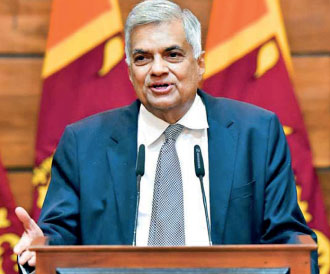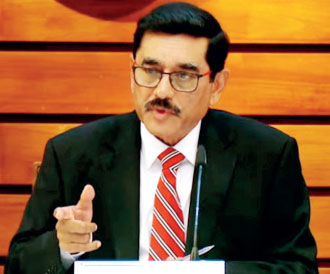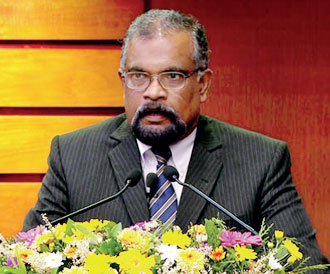Monday, 8 May 2023 00:14 – – 6665
 President Ranil Wickremesinghe
President Ranil Wickremesinghe Central Bank Governor Nandalal Weerasinghe
Central Bank Governor Nandalal Weerasinghe Treasury Secretary Mahinda Siriwardena
Treasury Secretary Mahinda Siriwardena
 When fears about a possible collapse of the Colombo Stock Market were expressed, President Wickremesinghe who is also the Minister of Finance firmly declared that he would close the stock exchange ignoring the domino effect of such an action on the credibility of the country. It seems that the President has been ill-advised by his advisors because if a country closes its stock exchange, it is demonstrative of a deep financial crisis. Before closing the stock exchange, a country should have closed all its banks and financial institutions and closing the stock exchange is the final step
When fears about a possible collapse of the Colombo Stock Market were expressed, President Wickremesinghe who is also the Minister of Finance firmly declared that he would close the stock exchange ignoring the domino effect of such an action on the credibility of the country. It seems that the President has been ill-advised by his advisors because if a country closes its stock exchange, it is demonstrative of a deep financial crisis. Before closing the stock exchange, a country should have closed all its banks and financial institutions and closing the stock exchange is the final step
 The widely predicted domestic debt restructuring
The widely predicted domestic debt restructuring
President Ranil Wickremesinghe, in his address to Parliament on the IMF bailout package, implied that, though a decision has not been taken yet, there is the possibility of restructuring the domestic debt of the central government. The instruments involved in the domestic debt are the Treasury bills, Treasury bonds and Sri Lanka Development Bonds commonly called ‘government securities’.
They are called domestic debt because they have been issued under the domestic debt laws like the Local Treasury Bills Ordinance or the Registered Stock and Securities Ordinance. A country should go for such a policy option when it finds it cannot service the debt, that is, repaying of the principal and paying of interest, by borrowing from the market and the debt service payments become unaffordable in relation to the revenue and the normal government expenditure programs.
Sri Lankan authorities proposing voluntary domestic debt optimisation
Prior to this, addressing the bilateral external creditors of Sri Lanka, the two heavyweights of the economic policy making of the country, the Central Bank Governor Nandalal Weerasinghe and the Treasury Secretary Mahinda Siriwardena, assured that any restructuring of domestic debt, which they termed as debt optimisation, will be purely on a voluntary basis. Optimisation is a concept used in economics to describe a situation where one seeks to maximise the gains if there is a profit opportunity and minimise the losses if it is in the opposite. Since debt restructuring involves cutting losses by investors, the optimisation is used here in the latter context. The choice before the investors in these government securities is, therefore, either losing everything or if they agree to optimise it voluntarily, saving a part of it.
Pressing the panic button of the investors
But this pronouncement by the Government sent fear-ripples across the economy activating the panic button of the people. There was a fear that, due to this voluntary debt optimisation, the public will lose a significant part of the financial assets they are holding, not necessarily in government securities. That is because of the operation of the ‘domino effect’ at the individual institutional level as well as at the national level. At the individual level, when in a financial institution one asset category incurs a significant loss causing the capital to be depleted, it affects the ability of the institution to repay the deposits. In that case, capital need be enhanced immediately to acceptable levels. At the national level, financial institutions are interconnected and interdependent, and therefore, losses in one institution or a in a group of institutions may cause losses in all other institutions as well.
Banks are also concerned
Knowing this, Sri Lanka Banks Association representing all the commercial banks of the country has expressed its concern demanding the authorities to clarify what is meant by ‘voluntary’ optimisation of domestic debt. When fears about a possible collapse of the Colombo Stock Market were expressed, President Wickremesinghe who is also the Minister of Finance firmly declared that he would close the stock exchange ignoring the domino effect of such an action on the credibility of the country. It seems that the President has been ill-advised by his advisors because if a country closes its stock exchange, it is demonstrative of a deep financial crisis. Before closing the stock exchange, a country should have closed all its banks and financial institutions and closing the stock exchange is the final step.
The fragile budgetary situation
The issue of domestic debt restructuring arises from the deeply fragile budgetary situation of the country. A country’s public debt is unsustainable, according to IMF, if the government of that country cannot meet all its current and future debt obligations without going for extraordinary financing programs without which it should compulsorily default its loan servicing (https://www.imf.org/en/Publications/fandd/issues/2020/09/what-is-debt-sustainability-basics#:~:text=A%20country’s%20public%20debt%20is,assistance%20or%20going%20into%20default.). In the case of the domestic debt, the extraordinary financing programs involve getting its central bank to issue new money to repay those loans. As long as the government is able to repay the maturing debt by borrowing from the market, the issue does not arise. But it depends on the gross expenditure and the gross financing requirements of the government.
A wider definition of public debt
However, the debt sustainability issues are considered normally by applying a wider definition for the public sector. According to that definition, debt sustainability should be viewed, in addition to the debt contracted by the central government, by considering the debt raised by the state and local governments, extrabudgetary units and social security funds. In Sri Lanka, the provincial governments and local governments have not borrowed from financial institutions or the market, and, hence, they do not pose a problem for the domestic debt sustainability analyses. However, debt raised by government corporations, state banks, the central bank, state-owned insurance companies, savings and development banks, public and private sector businesses that have borrowed under a guarantee from the government should be included in any meaningful debt analysis.
Gloomy public debt picture
When this wider definition is adopted, Sri Lanka’s domestic debt picture is not that rosy, because it is beyond the capacity of the government budget to meet the entirety of debt obligations. However, the Sri Lanka Government talks only about the optimisation of the central government debt. This narrow treatment of the public debt is the actual risk faced by Sri Lanka’s current as well as future taxpayers. They should be prepared to meet the obligations by cutting consumption and paying more taxes. Hence, President Ranil Wickremesinghe is correct when he says that conditions faced by Sri Lankans maybe worse tomorrow than today.
Government’s gross total expenditure and net financing requirement
In the analytical presentation of the budget, the stress is on the net financing requirement. That requirement is worked out by excluding the money which the Government should borrow to repay the maturing public debt on the assumption that it can raise new loans to repay the same. For instance, suppose the revenue of the Government is 100, its current expenditure is 110, and capital expenditure excluding the borrowing for repaying the maturing debt is 50. In this case, the net financing requirement is 60 and it is arrived at by subtracting the revenue of 100 from the total of the current expenditure and net capital expenditure that amounts to 160. Suppose that during the year the maturing debt is 40. When this amount is added to the expenditure of 160, the gross expenditure will be 200. Thus, the gross financing requirement is 100 which is arrived at by subtracting the revenue of 100 from the total gross expenditure of 200.
Gross financing and not net financing that matters
If the Government cannot borrow to repay the maturing debt, the applicable budgetary constraint is not the net financing requirement but the gross financing requirement. Sri Lanka is in this situation because it should increase interest rates to borrow all its financing requirements from the market. Since under the current IMF bailout package the Central Bank cannot supply funds for the Government to finance its budget, the country is at high risk of not being able to raise its gross financing requirements from the market. In that case, it may have to default its domestic debt obligations.
Ballooning gross government expenditure
The country’s gross financing requirement in 2023 has been put at 26.6% of an estimated GDP of Rs. 30 trillion during the year by IMF in its report submitted to the Executive Board for sanction the bailout package. This gives a gross financing requirement of Rs. 8 trillion. When the estimated revenue of Rs. 3.2 trillion is added, it gives a total gross expenditure of Rs. 11.2 trillion. However, in their presentation to the bilateral foreign lenders on 30 March 2023, the central bank and the ministry of finance have put the gross financing requirement during 2023 at 35% of GDP. This gives a gross financing requirement of Rs. 10.5 trillion. When the revenue of Rs. 3.2 trillion is added to this figure, the total gross expenditure of the government will amount to Rs. 13.7 trillion. It is this high gross expenditure figure coupled with the low revenue that will loom over the government’s ability to honour its debt repayment obligations during 2023.
Risk of not realising revenue targets
There is also the possibility of the Government not reaching its revenue target of Rs. 3.2 trillion during the year. According to a press release by the Inland Revenue Department, during the first quarter of 2023, the department has raised Rs. 316 billion by way of revenue. This has been compared with the achievement in the corresponding quarter in 2022 amounting to Rs. 146 billion. The department has expressed its satisfaction about the increase in revenue in the first quarter by some 116%. However, according to the budget approved by Parliament, the target of revenue by the department for 2023 is close to Rs. 2 trillion.
In terms of this revenue target, the amount which the department would have raised in the first quarter of 2023 should have been Rs. 500 billion if it is split on a pro rata basis. Though when compared with the realisation in the first quarter of 2022 it amounts to an increase of 116%, when compared with the budget of 2023, it amounts to only 63% leaving a sizable gap in the revenue.
 This is a timebomb clicking down to its ghastly explosion. It should be noted that while it is necessary for Sri Lanka to go for domestic debt restructuring, it is also important to do it in a manner causing the minimum pain to the economy
This is a timebomb clicking down to its ghastly explosion. It should be noted that while it is necessary for Sri Lanka to go for domestic debt restructuring, it is also important to do it in a manner causing the minimum pain to the economy
Need for cutting government expenditure
What this means is that to realise the annual revenue target of about Rs. 2 trillion, in the remaining three quarters, the department should work hard to increase its revenue realisation to Rs. 561 billion. If the second quarter also yields a low revenue realisation of, say 70% of the budgetary target of Rs. 500 billion, during the second half of 2023, the department should strive for a revenue realisation of Rs. 661 billion in each of the remaining two quarters. This is a challenging task for the Inland Revenue Department to realise the full target for the year. If the revenue falls below the budgeted target of Rs. 3.2 trillion and unless the Government cuts its current and capital expenditure drastically, the need for restructuring the domestic debt, even when one considers only the central government debt, will be a ground certainty and not just a possibility.
A combination of increased revenue and expenditure cutting fiscal consolidation
Sri Lanka Government is planning to resolve its fragile budgetary issue, including the issues relating to meeting the domestic debt obligations, through the increase in the tax revenue known as fiscal consolidation by increased revenues of the Government. As it is, this strategy has a limitation because there is an upper limit of increasing the tax revenue of the Government given the gloomy economic recovery and the drastic curtailment of the aggregate demand of both the private individuals and the Government under the macroeconomic stabilisation program currently being pursued. This curtailment of the aggregate demand is necessary to return to price stability which has gone haywire due to the irresponsible money supply increases in the past. But it has stunted the growth prospects and, according to the projections by IMF, growth will return steadily but slowly to 3% by 2028.
In this scenario, the prospect of raising a bigger volume of tax revenue sufficient to repay the domestic debt of the central government and to meet the debt repayment obligations of the wider public sector seems to be remote. Hence, it is necessary to adopt a combination of fiscal consolidation through the increase of revenue on one side and curtailment of public expenditure, on the other. The Ministry of Finance has postponed the capital expenditure programs which is also anti-growth.
There is not any observable plan by the Government to curtail its current expenditure which is ballooning year after year. Without such curtailment, the government’s gross expenditure and consequently the gross financing requirements will remain high. Since it compounds the government’s ability to service the domestic debt of the central government, domestic debt restructuring will become necessary.
Central Bank to go for debt reprofiling by law
The government owes some Rs. 3 trillion to the Central Bank, 2.7 trillion by way of Treasury bills issued and Rs. 300 billion by way of an overdraft facility known as Provisional Advances. The former is the main income source of the Central Bank. However, given the fragile budgetary situation, the government is unable to service this debt annually. This is to be resolved by incorporating a section in the transitional provisions of the proposed Central Bank Bill to convert this government’s liability to a 10-year negotiable bond.
While the terms of the bond have not been specified, it may be issued at a nominal interest rate like 5% to be paid on maturity. This will cut the Central Bank’s annual income flow making it difficult for the Bank to meet its annual committed expenses like payment of salaries to staff and day to day running of the Bank. Hence, it is important to decide on the terms of this bond without compromising the annual income flows of the Bank.
 The biggest challenge in domestic debt restructuring will be to ensure the financial system stability, while taking measures to reduce the debt obligations. Financial institutions as well as financial sub-sectors are interdependent and interrelated. Hence, when one institution is at stake, its impact will be felt by other institutions as well as other financial sub-sectors
The biggest challenge in domestic debt restructuring will be to ensure the financial system stability, while taking measures to reduce the debt obligations. Financial institutions as well as financial sub-sectors are interdependent and interrelated. Hence, when one institution is at stake, its impact will be felt by other institutions as well as other financial sub-sectors
Need for avoiding the domino effect on the financial sector!
The biggest challenge in domestic debt restructuring will be to ensure the financial system stability, while taking measures to reduce the debt obligations. As mentioned earlier, financial institutions as well as financial sub-sectors are interdependent and interrelated. Hence, when one institution is at stake, its impact will be felt by other institutions as well as other financial sub-sectors. For instance, if the stock market collapses, its impact will immediately be felt by the lending banks. This is because a large component of the funds required for its operation has been supplied by lending banks through margin lending.
When these loans become non-performing, lending banks will have to take a hit. Similarly, when the lending banks will have to suffer losses due to debt restructuring, their lending for margin trading will be curtailed and accordingly, the operations in the stock exchange will suffer. What this means is that domestic debt restructuring is a double-edged sword and if it is used irresponsibly, it is inevitable that all those who are involved in the exercise will get unnecessarily cut. Sri Lanka’s economy cannot afford to have that situation.
Defuse the timebomb without causing pain to the economy
This is a timebomb clicking down to its ghastly explosion. It should be noted that while it is necessary for Sri Lanka to go for domestic debt restructuring, it is also important to do it in a manner causing the minimum pain to the economy.
(The writer, a former Deputy Governor of the Central Bank of Sri Lanka, can be reached at waw1949@gmail.com.)

